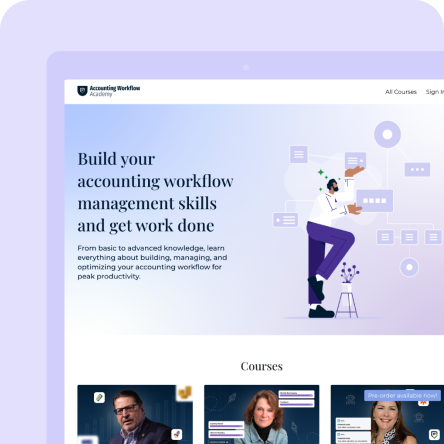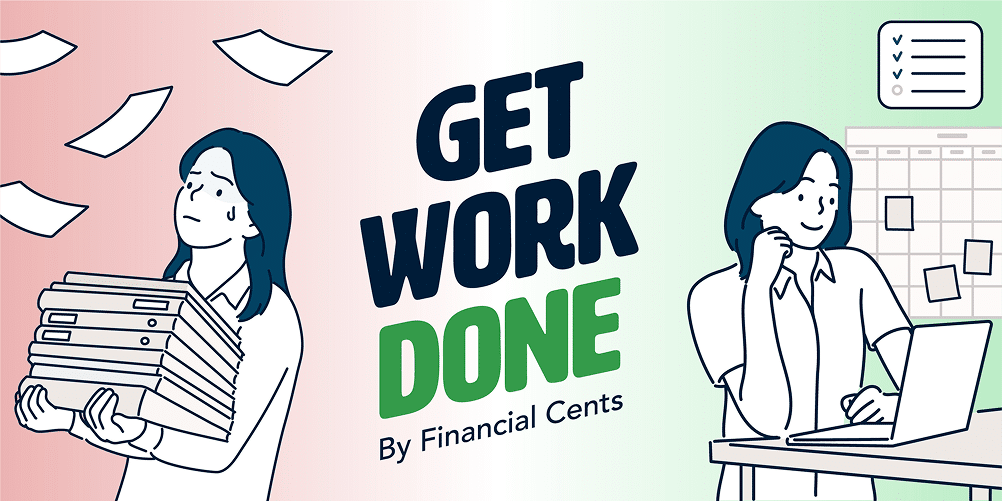Workflow Diaries is a series that explores the workflow processes firm owners have implemented to systematize their processes, improve productivity, and scale their firms. It is culled from our podcast, The Accounting Flow.
New clients bring a wave of enthusiasm but also a flood of paperwork. The initial burst of meetings, explanations, and information gathering can quickly become overwhelming.
It’s easy to get bogged down in defining the project scope, answering endless questions, and ensuring everyone is on the same page.
Did that essential tax form explanation get sent? Is this constant back-and-forth eating into valuable billable time? Does onboarding feel like reinventing the wheel each time?
The key to solving this lies in a streamlined client onboarding workflow.
Thankfully, Nikole Mackenzie, a 14-year accounting veteran, has developed a proven system to simplify the client onboarding process. She happily shared her background, workflow processes, and accompanying results in a recent episode of the Accounting Flow Podcast.
About Momentum Inc.
Nikole brings a wealth of experience to the accounting industry, having spent 14 years honing her skills. She took the leap seven years ago and founded Momentum, a Cloud Accounting Services (CAS) advisory firm. While their core focus is CAS, they also provide additional advisory services to their clients.
Momentum’s team of nine talented individuals, located across the US, Philippines, and El Salvador, provide remote accounting support for businesses looking to strengthen their financial operations.
They specialize in serving businesses with a revenue range of $1 million to $10 million. Momentum goes beyond basic accounting by also assisting with technology implementation and acting as a virtual fractional accounting department for their clients.
Nikole’s Workflow for Onboarding New Clients
In the early days, Nikole was the sole employee, providing fractional controller services, which typically involved working part-time with multiple companies and providing outsourced accounting expertise.
As the business grew and she hired more employees, they began working on-site with clients who already had their in-house accounting staff but relied on manual, paper-based systems. Their onboarding process was essentially to build a cloud-based accounting system for them.
Nikole soon realized this onboarding process wasn’t sustainable.
This shift necessitated a more systematic approach, prompting her to transition from handling all aspects of client service to focusing solely on sales.
Why sales you might ask?
As Nikole Mackenzie puts it, ‘Part of what I think of a good onboarding process is having a good sales process.’
Her approach to the sales process provides the perfect lead-up to a comprehensive onboarding process, which is then transferred to another team member – in this case, her onboarding manager – once a deal is closed.
Her systematic approach to client onboarding has helped Momentum cater better to its clients.
Here’s how it works:
During the sales process
Nikole uses Go Proposal to create a project plan for each client during the sales process. This plan prioritizes their most pressing needs for the first few months. It also outlines the order of operations, including handoff and accountability in clear terms.
According to Nikole, this helps her team ‘understand exactly what they need to do on an ongoing basis and what’s a priority during the onboarding process.’
Once the client signs the proposal, the project gets uploaded to their project management system and the team receives their tasks.
Additionally, Nikole records a video summarizing key client takeaways that address any important details not explicitly mentioned in the proposal.
Finally, she sends a kickoff email requesting access details and assigns the client to a dedicated onboarding manager, ensuring a smooth transition from the sales cycle to the onboarding phase.
Nikole spent the past seven years iterating, testing, and running Momentum with this onboarding strategy.
Kickoff Call
Following an initial email from the onboarding manager, a kickoff call introduces the client to the entire Momentum team assigned to their account.
This call utilizes a clear presentation outlining key personnel, roles, and essential contact information. Additionally, the proposal and timelines are reviewed to ensure everyone is on the same page regarding priorities and deliverables.
Weekly Check-In Meetings
During the kickoff call, the onboarding manager schedules a weekly meeting with the client for the next six weeks. This meeting is set to address any questions or concerns that the team might need clarification on and offer deep dives into specific areas of the client’s business.
The Offloading of Onboarding
After the initial onboarding period (typically 90 days), they have a new process called “offloading.” This involves reviewing the initial scope, completed work, and any additional needs identified. If there’s a significant change in scope, a price adjustment might be necessary at this point. Once “offloaded,” the client transitions to a different point of contact for ongoing service.
Focus on Customized Solutions
Momentum avoids pre-defined service packages. Instead, they prioritize understanding the client’s unique needs and crafting a customized solution. This helps them build a long-term relationship with the client, solve problems, and adapt to their evolving needs.
Going the Extra Mile
Nikole emphasizes the importance of exceeding client expectations during onboarding, even if unforeseen circumstances arise. Momentum prioritized this when a client required immediate assistance with a looming sales tax payment. While managing this issue fell outside the original scope of work, Momentum prioritized resolving the problem to make a positive first impression.
As Nikole Mackenzie puts it, ‘Let’s make an excellent first impression. Let’s go above and beyond as long as it’s in our way.’
One Point of Contact During Onboarding
Nikole emphasizes the importance of a single point of contact during onboarding.
We need one voice, one person the client communicates with during the onboarding process. And then they’re getting information from all the other individuals doing implementations or cleanup work to report that back."
Nikole Mackenzie.This streamlined approach ensures consistent communication and eliminates the confusion that can arise when clients receive conflicting information from various team members.
Clear Communication Channels
Clients receive contact information for the Momentum team, including a dedicated email address and phone number.
The client still needs to trust us. And we have to be very, very highly communicative."
Nikole Mackenzie.Internal Collaboration
Momentum conducts internal check-in meetings before each client meeting, guaranteeing everyone on the team is aligned and prepared to address the client’s needs effectively.
Here’s a comprehensive checklist of Nikole Mackenzie’s workflow process.
| Tasks | Status | Due Date | Assignee | Notes |
| Conclude the sales process/close the deal | ||||
| Handover to an onboarding manager | ||||
| Put together an entire project plan | ||||
| Get the client’s sign off on proposal | ||||
| Upload plan to project management system. | ||||
| Send a kickoff email. | ||||
| Organize client meetings with the entire team | ||||
| Weekly check-in meetings |
Actionable Tips
This conversation with Nikole offers valuable insights for creating a stellar client experience from the very beginning. Here are some key takeaways you can implement in your firm:
- Focus on Client Goals, Not Just Tasks: Shift the onboarding narrative to highlight how your services directly contribute to the client’s specific financial goals. This creates a stronger connection and demonstrates the value you bring.
- Streamline with an Onboarding Manager: Designate a single point of contact, like Momentum’s Jen Hoover. This ensures clear communication and a dedicated guide for the client throughout onboarding.
- Offer Multiple Communication Channels: Provide clients with various ways to reach you, including a dedicated email address and phone number. This flexibility fosters better communication and builds trust.
- Regular Check-Ins: Schedule regular meetings to keep clients informed, address concerns, and ensure everyone is aligned.
- Team Huddles: Before client meetings, conduct internal huddles. This ensures your team is prepared and aligned to effectively discuss client needs.
By adopting these strategies, you can emulate Momentum’s success and build a reputation for excellence in client service.
Results & Insights
When asked what her biggest takeaway from learning and creating her workflow was, Nikole says it is
having a clear cut-off between sales and onboarding and having everything in your project management system so that the team knows exactly what you sold, what needs to get done, and when the expectations are."
The benefit of this is that there is a clear separation of sales and onboarding, which prevents confusion and ensures that the team focuses on the right tasks at the right time. The sales team focuses on closing deals, while the onboarding team focuses on delivering those deals efficiently.
Furthermore, having everything in the project management system creates transparency for the team. They can easily see:
- What was sold: This clarifies the scope of the project and ensures everyone is aligned on deliverables.
- What needs to get done: Clear tasks and deadlines ensure accountability and efficient execution.
- Expectations: Knowing expectations around timing and deliverables avoids confusion and sets the client up for success.
In conclusion, implementing aspects of Nikole’s workflow, like clear project plans and client-focused communication, fosters a more efficient and satisfying onboarding experience. This translates to a win-win situation.
Clients appreciate the transparency and structure, knowing what to expect and when. Firms benefit from streamlined processes, improved team communication, and, ultimately, a stronger foundation for long-term client relationships.
However, the human touch should never be underestimated. Accounting software like Financial Cents will play a crucial role in managing tasks and timelines, but it’s the personal connection built throughout onboarding that creates a truly memorable experience.






